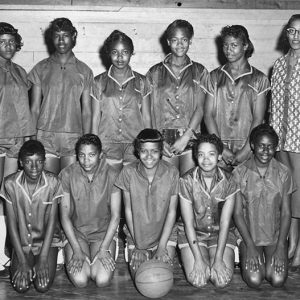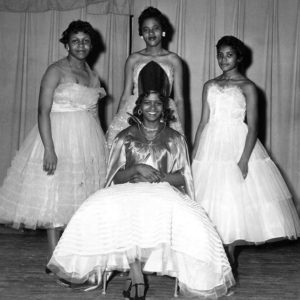calsfoundation@cals.org
W. F. Branch High School
Located in west Newport (Jackson County) on Arrington Avenue, W. F. Branch High School served as the town’s high school for black students until its closure in 1970. After the Brown v. Board of Education of Topeka, Kansas decision in 1954, some school districts in Arkansas, such as Charleston (Franklin County), Hoxie (Lawrence County), and Fayetteville (Washington County), desegregated successfully. In 1957, the attention of the nation focused on desegregation at Central High School in Little Rock (Pulaski County). The federal government allowed school districts to utilize the Freedom of Choice plan, which allowed for more gradual integration. In Newport, for example, the all-black Branch High School and the all-white Newport High School operated separately within the same district. In 1965, a gradual integration process was started by reassigning white teachers to Branch, black teachers to Newport High School, and allowing students to choose which high school they would attend. Newport Special School District continued to operate separate schools using the Freedom of Choice plan until 1971.
Originally known as the Newport Colored School, the school provided education only for elementary students in the two-story frame structure. According to the Arkansas Gazette in 1891, the “Colored school in Newport is said to be the finest and best arranged building of its kind north of the Arkansas River.” A two-story red brick building was erected in 1923 to meet the needs of a growing student population. Grades eight through twelve were added to the school between 1925 and 1948. With the help of a newly formed Parent Teacher Association, additional buildings for home economics and a boys’ shop were added by 1928. After 1954, the school changed its name to W. F. Branch to honor William Franklin Branch, who had been the school’s principal for twenty-three years, retiring in 1948.
As part of the Freedom of Choice plan, the district was required to publish, in newspapers and in letters to parents, courses that were offered at Newport High School but not provided at Branch High School. These included Latin, speech, distributive education, mechanical drawing, and diversified occupations. It is unlikely that these course offerings provided the motivation for Branch students to attend Newport High. In 1967, Willa Black became the first transfer student from Branch to graduate at Newport High. The dual school system continued, however.
In April 1968, a letter from the Arkansas Teachers’ Association executive secretary, T. E. Patterson, to Superintendent John W. Mullins pointed to “glaring inequities of salary between teachers with comparable qualifications and duties” at Newport High School versus those at Branch High School. No official reply to Patterson exists, but handwritten notes on the letter suggest that the disparity in pay existed because of a supposed disparity in work assignments. For example, the Newport High School band director was paid more because he conducted a seventy-five-piece band, whereas the Branch High School instructor was in charge of a twenty-five-piece band.
Further correspondence between the school district and the U.S. Department of Health, Education, and Welfare (HEW) reflected the district’s cooperative spirit in the desegregation process, which it had voluntarily undertaken in 1965. Federal inspectors found no evidence of discrimination in the district. Summer school, transportation systems, and adult education programs were desegregated. Fourteen teachers taught in schools in which their race was in the minority, resulting in black students being taught by white teachers and white students being taught by black teachers. Under the Freedom of Choice plan, one white student did enroll in Branch but later withdrew. By 1969–70, the dual school system was no longer acceptable to the HEW.
Letters received by Superintendent Mullins from U.S. Senator John L. McClellan and U.S. Senator J. W. Fulbright indicate that the district had urged those senators to support the Whitten Amendment in December 1969 to ensure “freedom of choice” for local districts. The amendment would have removed authority of the HEW to withhold federal money from school districts refusing to implement satisfactory desegregation plans. Both McClellan and Fulbright expressed support for continuing the freedom of choice plans, but the Whitten amendment failed with a 50–37 vote in the Senate.
Newport Special School District had drawn up plans for a new educational complex that would accommodate students from Newport High School and Branch High School. However, a period of inflation in the late 1960s made it difficult for the district to market bonds to finance the project. By January 1970, the district had contracted with T. J. Raney and Sons Municipal Bonds to work as the district’s fiscal agent, and construction on the new complex was scheduled.
By August 1970, Branch High was closed, and Newport High School was fully integrated. However, many black students were disenchanted with the process because none of the traditions from Branch followed them to Newport High School. The school mascot, school colors, and trophies just disappeared, and athletes felt their talents were underutilized, citing an instance of black basketball players being allowed to play only the last fifteen seconds of a game. The Newport High School prom was also canceled.
One day during lunch, several students decided not to return to class, and though most later returned under the threat of expulsion, several juniors and seniors quit school altogether, unable to bear the disappointment of losing their previous school and the pressures of integrating. After the demonstration, efforts were made throughout the 1971 school year to ensure equal participation by former Branch students in all extracurricular activities.
Branch High School students have formed an alumni association and have organized many reunions. In 2006, approximately 100 former students, some of whom traveled thousands of miles to attend, gathered at the Newport Country Club for dinner and a program. Only the ground story of the original building remains standing today. A community group, Brotherhood Unity, bought the property, renovating the campus and operating it as the Branch Community Center, which offered programs for school children and meal services. However, the center could not fund its programs adequately and closed its doors. In 2016, a local citizen purchased the campus with aims of reestablishing it as a community center. The site was added to the Arkansas Register of Historic Places on December 2, 2020.
For additional information:
Branch High School items. Jackson County Digital History Collection. http://cdm15320.contentdm.oclc.org/cdm4/browse.php?CISOROOT=/p15320coll4 (accessed September 27, 2022).
Mays, Gladys. W. F. Branch High School 1924–1970. Reunion Pamphlet, 2004. Arkansas Collection. Billingsley Library, Newport, Arkansas.
Mays-Cummings, Trisha. “W. F. Branch High School and Gladys Denson Mays.” The Stream of History 53 (2020): 99–101.
W. F. Branch High School Alumni Association. http://www.wfbranchhisch.org/ (accessed September 27, 2022).
Darby Wallace
Newport High School
 Branch High Girls Basketball Team
Branch High Girls Basketball Team  W. F. Branch
W. F. Branch  Annie M. Craft
Annie M. Craft  Alice N. Harris
Alice N. Harris  Newport Colored High School
Newport Colored High School  Queen and Court
Queen and Court 




Comments
No comments on this entry yet.